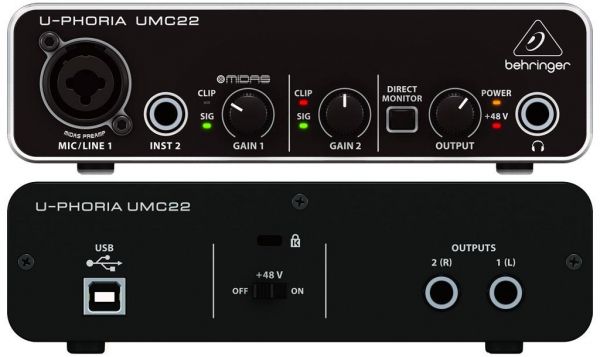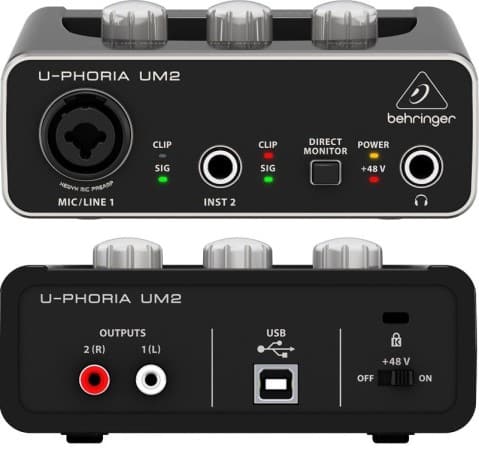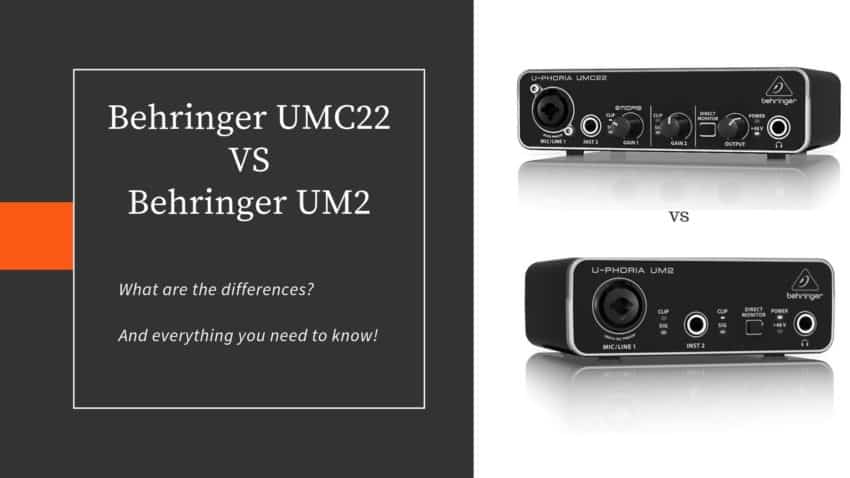Last updated on December 30th, 2023 at 02:53 pm
When it comes to affordable equipment, the people at Behringer have definitely made a name for themselves.
They produce some of the cheapest gear on the market, yet they all work pretty damn well…
The UM2 and the UMC22 are no exception to this rule.
But there is one question that I’ve seen way too many people ask which is; “Which of these two Audio Interfaces should I buy?” …
In this article I will give you a detailed description of both these interfaces, as well as their main differences.
Note: If you just want to read about what their core differences are, scroll down to the end of this post.
Let’s get started…
Behringer U-Phoria UMC22

This is a 2×2 Audio Interface, meaning that it can record two simultaneous tracks on to your DAW.
The build quality of the UMC22 is excellent.
It’s got an all-metal body which is really surprising considering how budget friendly it is.
When taking a look from the front you will be able to see all the controls and inputs;
Mic/Line, Instrument, Gain knob one and two, direct monitor switch, headphone output knob and headphone jack.
The only switch that’s on the back is the 48v phantom power one.
On the back you will also find the USB port as well as the right and left outputs.
All the knobs feel pretty sturdy… They do wiggle around a tiny bit but it’s definitely not something that you should worry about.
The Behringer UMC22 comes with the MIDAS preamps, not like the UM2 which comes with the XENYX ones.
These Preamps are actually quite good.
They will allow you to record at very low levels while still picking up every single detail, plus if you record too hot, at around -3dB, you won’t get any digital distortion whatsoever.
I mention this because on some cheap interfaces, like the UM2 and others, even if the signal doesn’t really clip, it still sounds distorted if it was clipping.
This won’t happen with the UMC22…
Also, the maximum recording quality you can achieve with the UMC22 is 48kHz at 24-bit, which is more than enough to get a studio-grade recording.
Now, what about the headphone output?
One thing that you should always take into consideration when buying an Audio Interface, is the headphone output…
Can it deliver enough power to drive high-impedance headphones? How is the overall sound quality? Does it provide zero-latency monitoring, etc.
Luckily, you won’t have any issues with it since it should provide enough power to drive high-impedance headphones while still sounding great…
Even the ones that have a 300 Ohm Impedance like the Sennheiser HD650.
Plus, it also provides the direct monitoring switch on the front which allows for some quick zero-latency monitoring.
All in all, it’s a decent audio interface which provides you with all the tools you need to do some basic recording that also sounds great.
Moving on…
How does it perform?
I just mentioned that the MIDAS preamps sound pretty good and that they will allow you to record both at really low- as well as high levels.
These are excellent preamps, especially for such a cheap interface.
You won’t have any gain issues with condenser mics, since you can get a decent signal with the gain set at 50%.
However, if you want to record dynamic microphones, some of which actually require a lot more power, like the Shure SM7B or the Heil PR40…
You will have to turn the gain up to 100% to get a good signal.
Still, very usable.
Now, does this interface have any latency issues? And the answer is no…
All interfaces have a bit of latency, but in most cases it’s not noticeable at all… and this is also the case with the UMC22.
Here’s a video where you can hear for yourself how it sounds…
Included Software
Tracktion 4; You need to register your UMC22 and after doing so you will receive a code to download the full version of tracktion 4.
Also included; 150 instrument/effect plugins.
I have an entire post about the best Free DAWs available where I talk about Cakewalk and Tracktion 7.
Both of them are completely free and, in my opinion, better than Tracktion 4.
I’d recommend you get the free effects and then use them with any of those two DAWs.
What comes in the Box?
- The Behringer U-Phoria UMC22
- USB Cable
Features
- 2×2 USB Audio Interface
- Compatible with all DAWs
- Low-Latency
- Great build quality
- MIDAS preamps
- 48v Phantom Power
- Great Headphone Output
- Free software
- 3-year warranty
Specifications
| Computer Connectivity | USB 2.0 |
| Simultaneous I/O | 2 x 2 |
| Number of Preamps | 1 |
| A/D Resolution | 24-bit/48kHz |
| MIDI I/O | No |
| Analog Inputs | 1 x XLR/TRS Combo, 1 x 1/4″ (Insert) |
| Analog Outputs | 2 x 1/4″, 1 x 1/4″ (Headphones) |
Find out more about the Behringer U-Phoria UMC22 here:
- Behringer U-Phoria UMC22: Amazon, Sweetwater.
Moving on…
Behringer U-Phoria UM2

The Behringer UM2 is very similar to the UMC22 in the sense that it provides the same number of ins and outs…
The resolution is also 48kHz with a bit depth of 24-bit and it also provides 48v phantom power and a good headphone output.
The difference lies mostly in the preamps which are the XENYX ones instead of the MIDAS ones.
When taking a look at the build quality I find that it’s… acceptable.
It’s entirely made out of plastic and it doesn’t fell at all durable.
I know that none of these super cheap audio interfaces are made to last for 10 to 15 years, but this one feels like it won’t really last much at all when compared to the UMC22.
The knobs have a lot of give to them which is something I don’t really like.
When taking a look from the front you can see;
The XLR/TRS combo input as well as the instrument input…
The direct monitor switch which allows for zero-latency monitoring, as well as the headphone output.
The rest of the controls such as gain and headphone output are on top of the interface.
On the back it has a stereo RCA Line Output, the USB connector and the 48v phantom power switch.
Moving on…
How does it perform
Honestly, when you consider the extremely low price tag, the UM2 is actually quite good and sounds great…
However, while you can record quiet music without losing a lot of the detail, the background hiss/noise will be noticeable.
Also, when you record a track that’s creeping up to where it’s about to clip, e.g. -3dB or -2dB, it will actually start to sound distorted without clipping.
I don’t like this at all…
Other than that, I think that it’s an outstanding piece of gear, considering the price… there’s a reason why it’s a bestseller everywhere.
However, I have to say that the MIDAS preamps are a lot better and if you have the budget for the UMC22, you should get that one instead of the UM2… no questions asked.
When it comes to the latency, again… no issues here.
Plus, having the zero-latency monitoring switch really comes in handy.
The headphone output is also quite impressive, since it can power high-impedance headphones easily.
All in all, it’s a great interface, just not as good as the UMC22.
Here’s a video where you can hear for yourself how it sounds…
Moving on…
Included Software
Tracktion 4; You need to register your UM2 and after doing so you will receive a code to download the full version of tracktion 4.
Also included; 150 instrument/effect plugins.
I have an entire post about the best Free DAWs available where I talk about Cakewalk and Tracktion 7.
Both of them are completely free and, in my opinion, better than Tracktion 4.
I’d recommend you get the free effects and use them with any of those two DAWs.
What comes in the Box?
- The Behringer U-Phoria UM2
- USB Cable
Features
- 2×2 USB Audio Interface
- Compatible with all DAWs
- Low-Latency
- XENYX preamps
- 48v Phantom Power
- Great Headphone Output
- Free software
- 3-year warranty
Specifications
| Computer Connectivity | USB 2.0 |
| Simultaneous I/O | 2 x 2 |
| Number of Preamps | 1 |
| A/D Resolution | 24-bit/48kHz |
| MIDI I/O | No |
| Analog Inputs | 1 x XLR/TRS Combo, 1 x 1/4″ (Insert) |
| Analog Outputs | Stereo RCA, 1 x 1/4″ (Headphones) |
Find out more about the Behringer U-Phoria UM2 here:
- Behringer U-Phoria UM2: Amazon, Sweetwater.
What are the Differences?
The UMC22 has a sturdier build as well as a better sound quality because it features the MIDAS preamps instead of the XENYX ones, which also makes the UM2 sound as if it was clipping way before it actually does.
Conclusion
I think it’s fair to say that the Behringer U-Phoria UMC22 wins this competition by a mile…
However, these interfaces are designed with budget in mind and you may not want to spend almost twice as much on the UMC22.
Both of these interfaces will do what they are supposed to do and quite good actually.
The one difference is that the UMC22 will provide better audio quality thanks to the MIDAS preamps.
Also, don’t forget about the much better build quality…
If you have the budget for it, go with the Behringer U-Phoria UMC22… no questions asked.
Otherwise, the Behringer U-Phoria UM2 is still a great alternative.
The best alternative, however, would be to get the Behringer UMC404 which is by far the most cost-efficient Audio Interface out there.
You can find that one in my recommended gear page.
I hope this information was useful!
Have a great day!

Thx for the article, Facundo!
I’m confused about one thing though, do you have to download software to use the UMC22 ? You write: You need to register your UMC22 and after doing so you will receive a code to download the full version of tracktion 4.
Can you use this USB Interface without Tracktion 4?
Does it still come with the audio bundles (guitar amps and effects, I’m assuming) even if you don’t download Tracktion 4?
Sorry for the questions, I was hoping to be able to use it with Garageband, just plug it in and be able to play/record my guitar/voice right in.
Thanks for any help!
Yes, you can use this interface with any DAW, not just Tracktion and you only need to install the drivers to do that, plus you should be able to get all the bundles as well.
The UMC22 has a Burr-Brown PCM2902 codec that has 89dB of dynamic range. Which makes 24bit recording comparatively pointless since it has not even 16bits of actual resolution. This is not really a recording interface for symphonic orchestras (and due to just a single microphone input, not intended for that purpose either). For personal takes and Internet jamming, it certainly beats a laptop microphone input, particularly since you can get good rewards from a phantom-powered microphone with solid gain. For amplifying comparatively weak signals like from a ribbon microphone, you’d likely want an interface with higher dynamic range. Also you’d not want to take stuff like jazz combos with it, but then it does not have enough inputs for that either. So it does have a few common-sense applications at its low price point.
Also it’s USB1.1 (full speed), meaning that the USB bandwidth for full-duplex gets rather taxed.
Can I take the output from a digital piano’s stereo headphone/line out and connect the left to the Line 1 and the right to the Inst2 with 1/4″ TS (mono) plugs? Then the L/R outputs would go to a set of powered speakers. I wonder if the gain controls could get the levels right.
The idea is to mix the piano output with audio from the computer and send it to the speakers.
The store couldn’t source a Behringer UCA202 for me so offered the UMC22 instead.
I think the burning question here is actually:
Will anywhere ever actually have these in stock?
Thank you very much for the info! 🙂